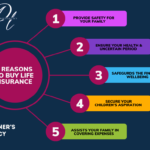How to Get Education Insurance
In 2024, securing your child’s educational future is more critical than ever. Education insurance provides financial stability and peace of mind, ensuring your child’s academic needs are met even in unforeseen circumstances. This guide will walk you through everything you need to know about getting education insurance, with a focus on leveraging AI in your blogging strategy to spread awareness and provide valuable information. Your desired text has been saved for future reference.
Understanding Education Insurance
Education insurance is a type of policy designed to cover the educational expenses of your child. These policies typically provide a lump sum amount at crucial stages of your child’s education, such as at the start of college. Education insurance plans can also cover tuition fees, accommodation, books, and other related expenses. These plans come with additional riders for critical illness, disability, or accidental death, ensuring comprehensive coverage. When choosing the best plan, consider factors such as premium affordability, flexibility in withdrawals, and the credibility of the insurance provider.

Which Plan is Best for Child Education?
The best plan for child education depends on various factors, including your financial situation, the age of your child, and your long-term educational goals. Here are some popular options:
1. Unit-Linked Insurance Plans (ULIPs)
These are market-linked insurance products that offer both insurance and investment under a single integrated plan. They provide the dual benefit of investment growth along with insurance coverage. These plans come with additional riders for critical illness, disability, or accidental death, ensuring comprehensive coverage. When choosing the best plan, consider factors such as premium affordability, flexibility in withdrawals, and the credibility of the insurance provider.
2. Traditional Endowment Plans
These plans offer a combination of insurance and savings. They are ideal for risk-averse individuals as they provide guaranteed returns and a maturity benefit along with life cover. These plans come with additional riders for critical illness, disability, or accidental death, ensuring comprehensive coverage. When choosing the best plan, consider factors such as premium affordability, flexibility in withdrawals, and the credibility of the insurance provider.
3. Scholarship Plans
These plans specifically cater to funding higher education. They typically offer payouts at predefined stages, such as at the start of college or each semester. These plans come with additional riders for critical illness, disability, or accidental death, ensuring comprehensive coverage. When choosing the best plan, consider factors such as premium affordability, flexibility in withdrawals, and the credibility of the insurance provider.
4. Savings Plans with Riders
These plans come with additional riders for critical illness, disability, or accidental death, ensuring comprehensive coverage. When choosing the best plan, consider factors such as premium affordability, flexibility in withdrawals, and the credibility of the insurance provider. These plans come with additional riders for critical illness, disability, or accidental death, ensuring comprehensive coverage. When choosing the best plan, consider factors such as premium affordability, flexibility in withdrawals, and the credibility of the insurance provider.
What is the Education Savings Plan in Pakistan?
In Pakistan, there are several education savings plans designed to help parents save for their child’s education. Some notable plans include: These plans come with additional riders for critical illness, disability, or accidental death, ensuring comprehensive coverage. When choosing the best plan, consider factors such as premium affordability, flexibility in withdrawals, and the credibility of the insurance provider.
1. State Life Insurance Corporation’s Shad Abad Education Plan
This plan offers financial support for a child’s education, covering school fees, college fees, and other educational expenses. 2. EFU Education Plan**: This plan provides a regular stream of income to cover educational costs, ensuring that the child’s education continues without financial interruptions. These plans come with additional riders for critical illness, disability, or accidental death, ensuring comprehensive coverage. When choosing the best plan, consider factors such as premium affordability, flexibility in withdrawals, and the credibility of the insurance provider.
3. Jubilee Life Insurance’s EduPlan
Aimed at providing financial security for a child’s education, this plan offers flexible premium payment options and guaranteed returns. These plans often come with tax benefits and the option to customize coverage based on your financial capabilities and educational aspirations for your child. These plans come with additional riders for critical illness, disability, or accidental death, ensuring comprehensive coverage. When choosing the best plan, consider factors such as premium affordability, flexibility in withdrawals, and the credibility of the insurance provider.
Which Insurance is Best for a Child?
The best insurance for a child combines affordability, comprehensive coverage, and the flexibility to adjust to changing needs. Some of the top options include: Whole Life Insurance Provides coverage for the lifetime of the insured and includes a savings component, which can be used for education expenses.2. * Offers pure protection for a specific period. While it doesn’t build cash value, it provides substantial coverage at a lower cost. These plans specifically focus on funding educational expenses and are tailored to provide payouts at crucial educational milestones. Health Insurance**: Ensures that medical emergencies do not derail educational funding by covering medical expenses. When selecting an insurance plan for a child, consider factors such as the sum assured, premium payment options, policy term, and additional riders for critical illnesses or accidents.
Which Policy is Better for Children?
The ideal policy for children depends on individual circumstances, but here are some general recommendations: Child Endowment Plans**: These plans are popular for their guaranteed returns and life cover. They ensure that the child receives a lump sum amount at maturity, which can be used for higher education. These plans come with additional riders for critical illness, disability, or accidental death, ensuring comprehensive coverage. When choosing the best plan, consider factors such as premium affordability, flexibility in withdrawals, and the credibility of the insurance provider.

2. Money-Back Plans
These plans provide periodic payouts during the policy term, ensuring that educational expenses are met at various stages of the Your desired text has been saved for future reference. children’s academic journey. These plans come with additional riders for critical illness, disability, or accidental death, ensuring comprehensive coverage. When choosing the best plan, consider factors such as premium affordability, flexibility in withdrawals, and the credibility of the insurance provider.
3. ULIPs with Education Benefits
These plans offer market-linked returns and the flexibility to invest in different funds based on risk appetite. Comprehensive Child Plans These plans combine life insurance, investment, and savings, providing a holistic approach to securing a child’s future. When choosing a policy, assess the credibility of the insurance provider, the financial strength of the policy, and the benefits offered at different stages of the child’s education. These plans come with additional riders for critical illness, disability, or accidental death, ensuring comprehensive coverage. When choosing the best plan, consider factors such as premium affordability, flexibility in withdrawals, and the credibility of the insurance provider.


